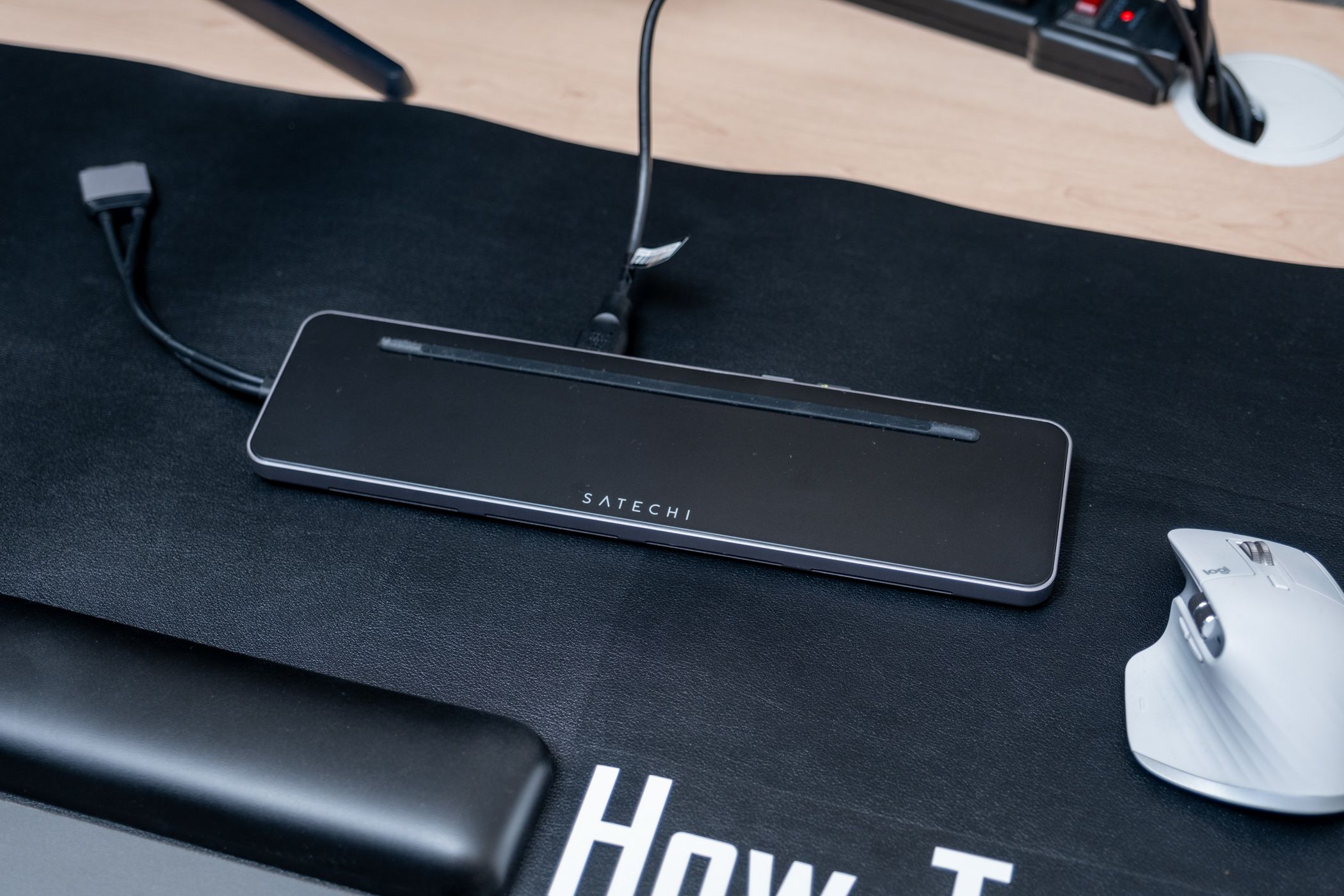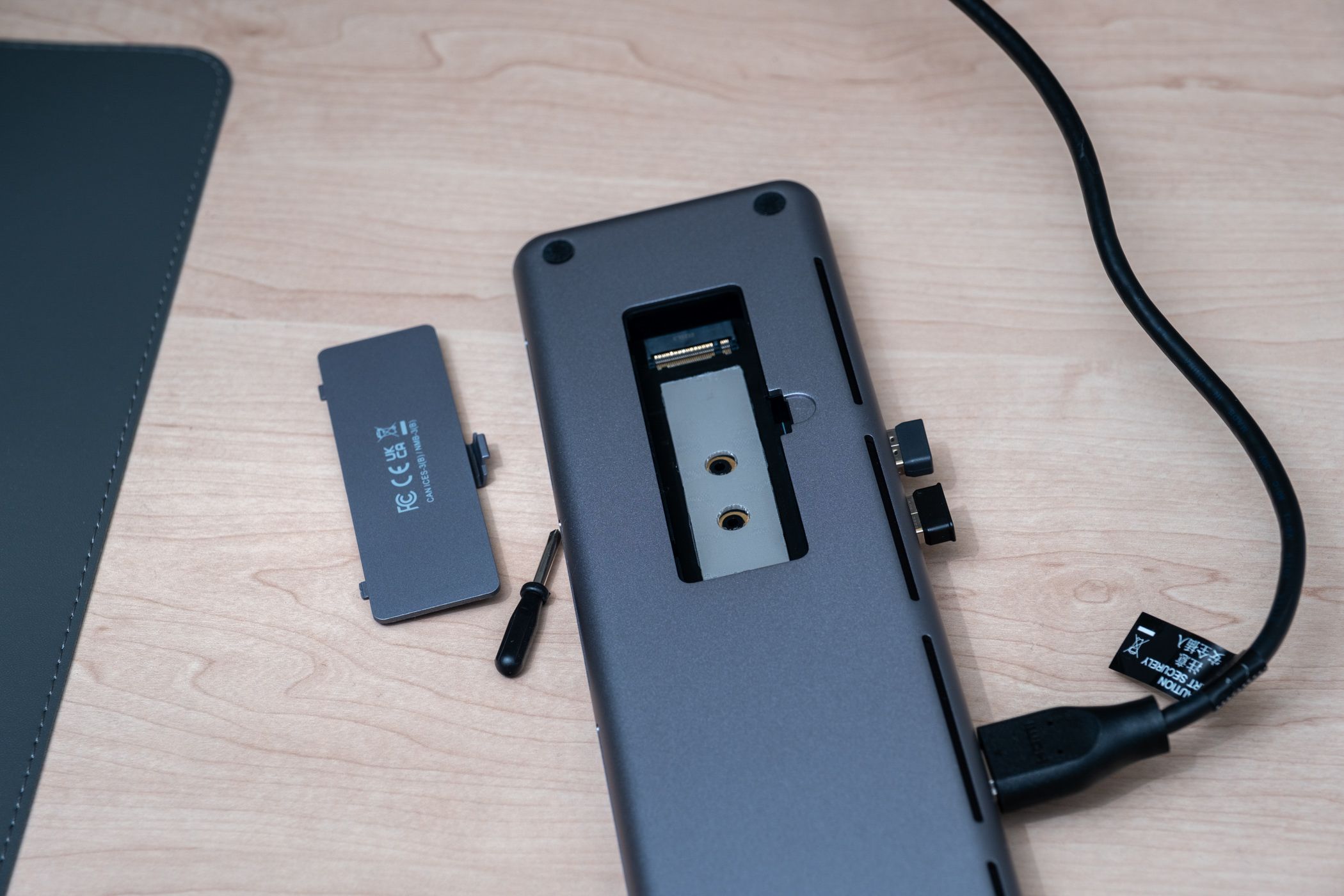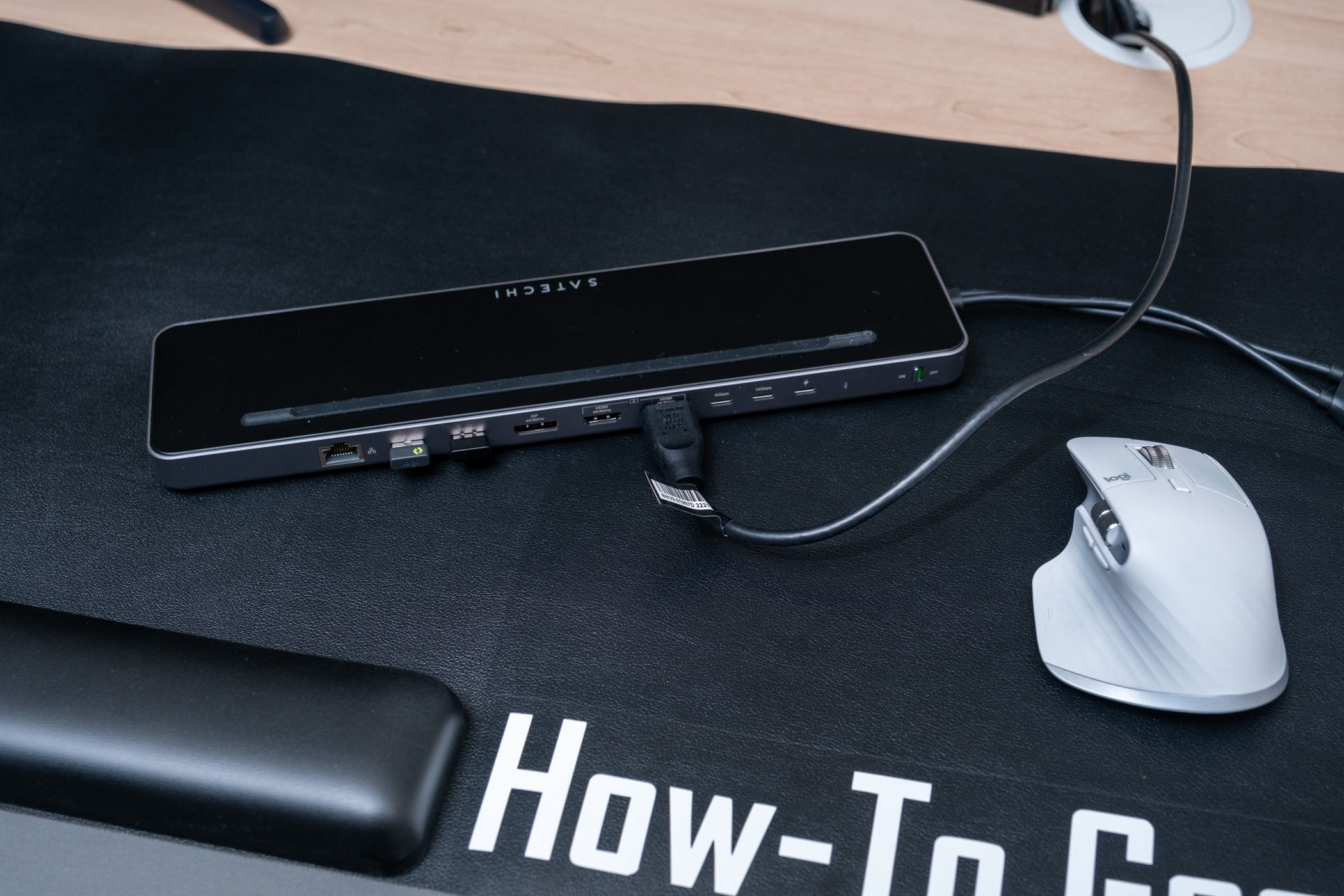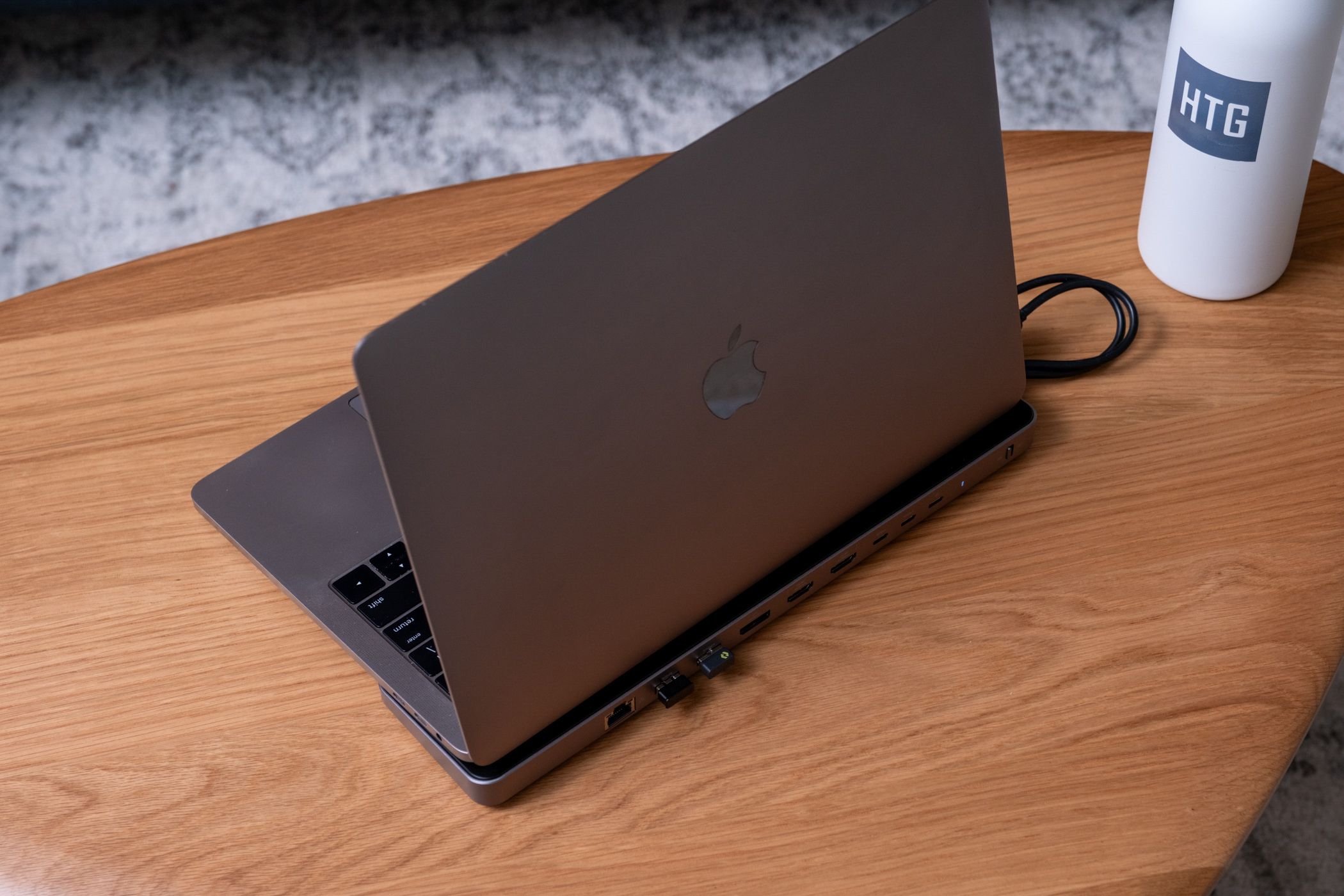Key Takeaways
- The Satechi Dual Dock Stand provides nine ports and an M.2 SSD enclosure, giving you additional storage and connectivity options for your laptop.
- With dual 4K/60Hz display support, the stand allows you to create a powerful at-home workstation using your laptop, without the need for an expensive desktop tower.
- While primarily aimed at MacBook users, the Dual Dock Stand is also compatible with some Windows laptops that have a dual USB-C port setup, providing flexibility in its compatibility.
Laptops are great portable devices, but they can lack enough storage or necessary ports. The Satechi Dual Dock Stand can solve both of those issues by giving you nine extra ports to play around with, and an M.2 SSD enclosure to add extra storage for your laptop.
With its dual 4K/60Hz display support, you can set up an awesome at-home workstation with your laptop instead of investing in an expensive desktop tower. The best laptops are usually decked out with a pretty stunning built-in 14- to 17-inch screen, but sometimes that’s not enough visual space for your work. This Dual Dock Stand lets you add extra space to your overall display setup by pairing two desktop monitors with your laptop screen for a total of three displays.
Satechi’s Dual Dock Stand is aimed at MacBook users, but it’s compatible with some Windows laptops that have a dual USB-C port setup, like the Microsoft Surface Pro 9, Lenovo Yoga 7i, or Dell XPS 15. Most MacBooks support dual external displays, but if you have an M1/M2 MacBook, you’ll be limited to a single external display (because of Apple, not Satechi).
There’s a lot to love about this laptop docking station, and it truly does enhance usability by letting you easily add Ethernet, external displays, and more peripherals to your setup. However, it’s not perfect. A few elements were clunky or confusing, but the positives far outweighed the negatives with the Satechi Dual Dock Stand.

Satechi Dual Dock Stand
The Satechi Dual Dock Stand offers an M.2 SSD slot for extra storage, and nine different ports to round out your laptop setup with peripherals, including up to two 4K/60Hz external displays.
- Ports
- 1x USB-C PD pass-through port up to 75W, 2x USB-C data ports (1x 5Gbps, 1x 10Gbps), 2x USB-A ports (1x 5Gbps, 1x 10Gbps), 2x HDMI 2.0 Port (4K/60Hz), 1x DisplayPort 1.4 Port (4k/60Hz), 1x Gigabit Ethernet Port
- USB Power Delivery
- Yes
- Supported HDD sizes
- M.2 2242, 2260, or 2280 SSD
- Nine ports total, including Ethernet
- Built-in M.2 NVMe SSD slot
- Supports dual display setup
- Small, easily portable laptop stand
- Cables for laptop are a little short
- Laptops need two USB-C ports side by side for full functionality
- No SD card reader
Price and Availability
At the time of writing, you can buy the Satechi Dual Dock Stand from Satechi’s website for $149.99. Any purchase over $40 receives free shipping, so you’ll only have to pay any applicable taxes on top of the stand’s retail price. Many of Satechi’s other products are available on Amazon, so the Dual Dock Stand could eventually make its way there as well.
Design
This Dual Dock Stand has a sleek, minimalist design, just like many of Satechi’s other products. It’s constructed using high-quality aluminum, and it’s mainly a space-gray color with a black top. The stand weighs less than one pound and sports a small form factor, making it the perfect travel companion for your laptop if you need extra ports and storage on the go.
There’s a black rubber strip on the stand’s top to help hold your laptop in place while connected. The stand’s underside also features a black rubber dot in each corner to prevent movement between the stand and your desk. On the front of the stand, there are four thin vents for warm air inside the stand to escape. There’s no built-in ventilation for heat from your laptop, but the stand does create space between your desk and your laptop for heat to dissipate. Depending on your laptop and where you place it on the stand, your laptop’s fans could be covered by the stand.
For example, I needed to move my Lenovo Yoga 9i laptop forward on the stand a little to expose the fans underneath and promote better heat dissipation. The small vents in the stand can release some of the heat produced by your laptop, but likely not as much as your laptop’s fans can push out when there’s space to do so.
Satechi’s Dual Dock Stand does slightly raise your laptop for a more comfortable typing experience. However, if you’re working from home or otherwise spend a lot of time on your laptop at your desk, this stand doesn’t provide enough height on its own to help ease discomfort for your neck, shoulders, and back.
Ports and Connectivity
In addition to the nine total ports at the back of the Dual Dock Stand, there’s also a slot for an M.2 SATA/NVMe SSD (not included) to add extra storage to your laptop setup. Beneath a small plastic door on the stand’s underside, you’ll find a built-in thermal pad, a tiny screwdriver, and a screw to help you install an M.2 2242, 2260, or 2280 SSD.
To connect the Dual Dock Stand to your laptop, there are two USB-C connectors with only six inches of cable length. Because these cables are sturdy and thick, they were a bit hard to maneuver. If your laptop doesn’t have two USB-C ports on the left side, you won’t be able to fully utilize the Satechi Dual Dock Stand.
This stand is designed with MacBooks in mind, so the aluminum cable cover for the dual connectors needs to be moved down for any other laptop. Otherwise, the spacing of the two USB-C cables likely won’t be right. The USB-C connector labeled 1 is in charge of power delivery, and the one labeled 2 is in charge of speedy data delivery. You can use the USB-C connector labeled 1 for both power and data delivery, but data delivery won’t be nearly as fast.
You can connect the dock to your laptop in a few different ways. If your laptop has three USB-C charging ports, you can connect your laptop charger directly to your laptop, and then connect the dock directly to your laptop via the dual USB-C connectors. If your laptop only has two USB-C ports side by side, you can plug your laptop’s USB-C charger directly into the dock, and then connect the dock to your laptop via the dual USB-C connectors.
Laptops with only one USB-C charging port or two located on opposite sides won’t be able to appreciate the full capabilities of this dock stand. You can just plug in the USB-C connector labeled 1 to send power to the dock and charge devices, but without speedy data delivery, the $150 price tag isn’t as worth it.
When the dock is receiving power (as indicated by a light near the ports), you can use the ports on the back to charge other devices or connect peripherals with USB-RF dongles. More power-demanding devices (smartphones) will charge slower with a cable connected through the dock, but smaller devices, like my Galaxy Watch 6, charge at normal speed.
Connecting your Wi-Fi router to the dock through the Ethernet port offers a speedier experience. I performed a few internet speed tests prior to and after connecting to my router via an Ethernet cable, and on average, my download speeds were about twice as fast and upload speeds improved only marginally.
The last three ports are all for connecting external displays to your setup. Between the three ports, you can only connect a max of two external displays. Dual displays will be capped at 4K resolution with a 60Hz refresh rate, or you can connect a single display with the DisplayPort for 4K resolution at 120Hz.
Intel-based MacBooks, M1/M2 MacBooks with Pro or Max chips, and some compatible Windows devices will support dual display through Satechi’s Dual Dock Stand. If you have a non-Pro or Max M1/M2 MacBook, however, you can only connect a single external monitor. This isn’t a limitation of the dock stand; it’s a limitation imposed by Apple that prevents laptops in extended mode from supporting more than one external monitor.
The dock doesn’t offer an SD card slot, which seems like an odd omission. SD cards may not be used as frequently as they used to be, and many laptops omit these slots in their designs, but it’s usually a standard slot on a docking station.
Should You Buy the Satechi Dual Dock Stand?
If your laptop features a dual USB-C port setup and you’ve been looking for something to add ports and storage to your laptop, you should absolutely buy the Satechi Dual Dock Stand. It’s small, fairly easy to set up, and can help you create a clean, efficient workstation at home.
For anyone with a laptop that doesn’t have a dual USB-C port setup, it’s probably smarter to go with a different docking station. Without both of the dock’s cables plugged into your laptop, you’d lose out on data transfer speeds. If this isn’t important to you, and the idea of a built-in SSD slot and nine incredibly useful ports is enough, then you could be happy with this dock stand in your laptop setup.
For the best experience, this laptop docking station should be paired with a monitor riser stand so your laptop can be at eye level and still benefit from the extra storage and ports Satechi’s stand offers. Then, you could add in a great wireless mechanical keyboard and a wireless mouse to round out your setup.

Satechi Dual Dock Stand
The Satechi Dual Dock Stand offers an M.2 SSD slot for extra storage, and nine different ports to round out your laptop setup with peripherals, including up to two 4K/60Hz external displays.








